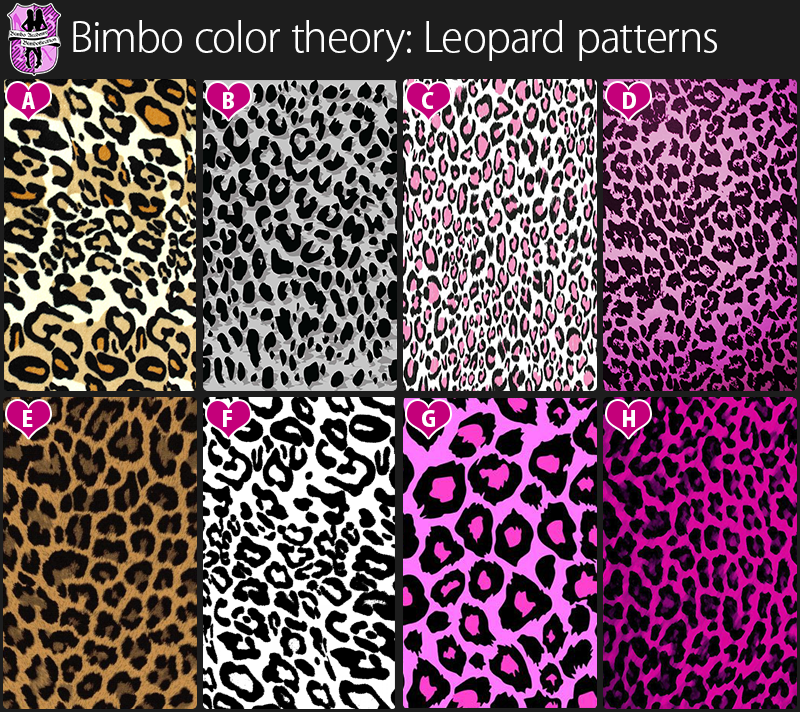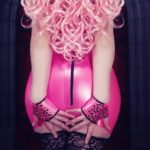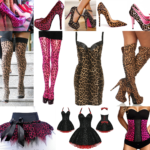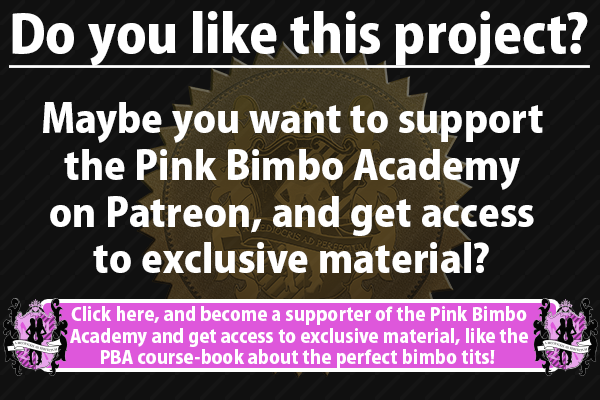Theorizing about the color pink in our first “bimbo color theory” posting, marks the very basics for every further article about colors and combinations of colors for bimbos and gimbos, because pink remains as the most important first choice for every doll and every trainee and will return in every future theory about suitable sample boards for any acceptable collection of clothes, styles and accessories. Even in todays article, pink is a vital ingredient and addition to our next topic: The first post about bimbo color patterns, in fact in a little sub category called “animal print”, “leopard patterns”! For the sake of simplicity, this article treats “leopard” and “cheetah” -patterns the same – because though there are differences, the overall effect of the pattern remains the same and the same rules do apply. Let us first have a look at the definition and the construction of those patterns, after that, I won’t mention the cheetah pattern again as a separate sample. Beforehand: Leopard patterns, as part of the category of “animal prints” don’t have anything to do with real animal fur! Most of the time, it isn’t even the goal of these patterns to simulate something like the real fur of an animal, but rather to aim at the simple flat, photographic, or graphic, representation of the colors and the patterns of a specific animal skin. Often, if fur is the look that has to be achieved, many items are made from fake fur.
The setup:
The leopard pattern consists, most of the time, of three different colors, one base color as the canvas for the actual pattern, and two different element colors, one of them (main element), nearly every time being black, the other one (secondary element), most of the time, a darker variant of the base color, placing it somewhere between the canvas and the first element color in terms of brightness. In some versions, the secondary element may be omitted (figures “F”&”D”), though it doesn’t happen very often, because of the loss of the typical impression the setup is trying to achieve. The classic base color is a golden, sometimes bright, brownish, yellow, covering the whole canvas (item) without any specific form or shape, just working as a base filler (figures “A”&”E”). As already said, the first element is black, most of the time, functioning as the main shape giving aspect, absolutely determining the overall impression, consisting of horseshoe-like dark blotches, forming a ring around the second element. As stated, the second element is an amplified or muted version of the base color most of the time, filling up the space circled by the first element, giving the leopard its typical complicated two-toned spots pattern. Here lies the difference between the leopard print and the cheetah print: While the leopard is defined by a complicated and varying two-toned spot design, the cheetah pattern is a more simple issue, with a two color setup, simple dark spots without the second element of the leopard, while sharing the same overall color palette. I would suggest to any bimbo doll to go for the leoprad print, because it may seem more eye catching and interesting with that third color added to it, but it makes no real difference regarding the message and is absolutely free for the bimbo to decide what she prefers. I already stated, that the natural base color is a golden yellow, with a black first element and a dark brownish second element. This is easily the most abundant and most common texture you will see on bimbo clothes and
accessories – and is perfectly acceptable! You can see the appeal of those variants on many of the pictures above. A step up in terms of typical bimbo colors is a switch from golden to a bright pink for the base color, a remaining black for the first element and a darker pink or purple for the second element (figures “G”&”H”). Remembering pink as the most valuable color for bimbos and a clear statement in terms of bimbo appeal, this choice is
greatly appreciated! Another possible and often chosen variant consists of white or silver as the canvas, black for the first element and a darker grey for the second element (figures “B”&”F”). This variant has another benefit, namely the high contrast between the different elements, creating tension and attention. There are different other variants for a bimbo to chose from, even mixtures of already established combinations, like white-black-pink (figure “C”) – cute and girly, or versions with actual reflective, metalish, glossy golden or silver base colors – which add a luxury and classy appeal to it. Every bimbo may freely chose from these different colors and is free to experiment with different versions. Gimbos however, might end up with the pink-black-purple or the silver-black-dark grey designs most of the times, although they are free to chose any version here too. All of these versions are acceptable, and should be chosen based on the type of bimbo, the occasion, the overall style and the kind of item the texture is applied to.
The history:
A brief look at the history of animal print will help us to better understand the appeal of the leopard pattern, and why it is a perfect and most fitting texture for every bimbo and every gimbo: Animal prints have long been a popular style for many reasons. Being a symbol for wealth and status because of its general high expense and the consideration to be rather exotic and rare, kings, queens and other high people used animal print rugs as a sign of high status and power in olden times. Even in non-western cultures, animal fur, especially that of wild predators, was and is still used as a symbol of might and a high social rank, because it is always connected with the feared, powerful abilities of the predator and further, with the needed strength and courage to hunt that animal down to obtain its fur. During the bohemian movement in the 1960s, the animal print became highly popular for woman in the United States, even if it already was around way earlier as a statement in the world of fashion. After that time, the leopard pattern, even the whole animal print began it’s “descend” from “high-fashion” to “low-class” and that is the time when it obtained the connotations it is still associated with (even if it is rising back again to high fashion these days!). These connotations are one of the major reasons why these patterns do fit a bimbo perfectly and why every bimbo should wear animal print in general as often as possible. We will have a look at these connotations in the next chapter. These negative thoughts began with Christian Dior, warning woman “If you are fair and sweet, don’t wear it.” of animal print in his fashion bible, and later when “
the trophy-wife-in-a-leopard-coat trope crashed in the late 1960s, with
Anne Bancroft’s appearance as the frustrated and malevolent (but
insanely stylish) trophy-wife-turned-predator in The Graduate
(…)” (– Jo Weldon), to the well known Peg Bundy, wearing animal print many, many times, marking the lowest point in general regards in terms of signs of taste, style and wealth. But what exactly are these regards?
The look:
“Cheetah Print is a design on a material often clothes that resembles the
fur of a Cheetah. Cheetah print clothing is most often worn by ladies
who often provide certain services to a man for pay. When it come to hookers the ones in Cheetah print often are the lower end whores, like if your looking for a five dollar blow-job.” – The urban dictionary about cheetah print.
This is the general idea, many people have of leopard print, worn by sexy girls and woman. And isn’t this a good thing? Isn’t this reason enough for a bimbo to wear leopard patterns every day? Of course it is! But there’s more to it. And we want to understand why these effects exist. The fur of a leopard is designed to blend with its surroundings, making it possible for the predator to hunt down its prey from the flora and the shadows of their natural environment. Something that works surprisingly well, in fact, it works out so amazingly well, that this pattern came out on top in several completely different environments totaly independent from each other, like on several great cats, reptiles, fish, frogs and even insects. It may seem unintelligible on the first glance, that a texture that aims at rendering its carrier invisible at best, is a good choice for a bimbo, a being that wants to draw as much attention and regard as possible and wants to stand out, but there are two very good explanations for this: 1. We, as humans, have a long history of being chased by those predators. In times of pre civilizations, careless humans would have been torn apart from giant cats with razor sharp teeth. As adaptation and evolution works, humans had to get really good in spotting the dreadful spotted fur of those killers in order to survive. This lead to the development of a special kind of alarm senses we humans still have, immediately focusing ones attention to the creature, wearing that alarming texture, once it is perceived. So a pattern that should blend in, became a pattern that draws our attention immediatly and lets us focus on it. 2. The environments that these textures should adapt to, don’t exist any more around us, letting them stand out even more. The leopards fur is something special in front of some urban backgrounds. Now it is much more clear, why the leopard pattern draws our gaze and attention and lets it carrier stand out in the best way possible. Next thing is our sexual connotation regarding cats: It is not without a reason, that catgirls are a common sexual fetish, and are even more popular than bunnies! Jo Weldon states that leopard print continues to be associated with sex appeal and femininity: “(…)
because leopards are so hard to domesticate. And we seem to associate cats in general with sexuality.” (– Jo Weldon). This may be a result from the grace and elegance with which cats move and hunt, something that always led to sexualized woman with cat-typical themes and properties, like the infamous and simply outstanding and amazing, sexy performance of Michelle Pfeiffer as (the only legit) Catwoman in Tim Burtons “Batman Returns”. These reasons, as well as the sprawling use of leopard patterns by “lower class”, cheap girls, hookers and trophy wives led to the biasses many people have today, thinking of these patterns. More than enough reasons for any bimbo to obtain as many different items and styles with this texture as possible:
The items:
Everything. Simply everything is available with proper leopard pattern textures. From high heels, overknee boots, handbags, purses, dresses, skirts, corsets to stockings, bras, underwear, panties and even the notorious Louboutin pumps are available with sexy leopard patterns. And a true bimbo doll should try to get as many items as possible! Have a look at many of our rolemodels, wearing respective
accessories
or dresses, here, here and here! We already had a stylecheck where the leopard pattern played the major role for the whole style of two amazing dolls, presenting a classic and a pink style at the same time. In fact, this texture made an appearance more than once in our style checks, which is not without a reason, as the leopard print can be regarded as essential in the bimbo culture! As already said, there are no restrictions for you, regarding the styles above, so you can chose between pink leopard patterns and silver ones at least, as a good gimbo girl, and every thinkable one as a good bimbo doll. Draw attention! Stand out! Be a sexy, seductive and alluring bimbo cat!
Support me on Patreon if you like what I’m doing here! Thank you very much for your support!





